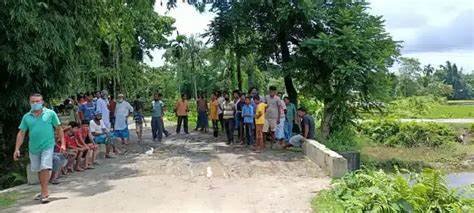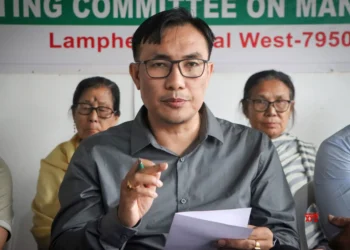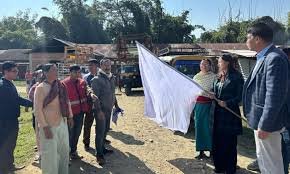The Assam government’s decision to allocate Paglijhora’s forest land to Adani for a coal-powered plant has sparked fears of widespread pollution, soil erosion, and biodiversity loss.
BY PC Bureau
une 17, 2025 – The Assam government’s decision to allocate approximately 480 hectares of forest land in the Paglijhora area of Kokrajhar district to the Adani Group for a thermal power plant has sparked intense controversy, widespread protests, and serious concerns about an impending environmental disaster. The proposed site, located in the Parbatjhora Forest Division under Bashbari, is home to over 500,000 sal and teak trees and a rich ecosystem supporting diverse flora and fauna. The project’s potential to devastate forest life, coupled with its questionable legality under the Sixth Schedule of the Indian Constitution, has made it a flashpoint for environmental and indigenous rights advocates.
READ: Rift between the Omar-led government and the LG’s administration deepening in J&K
Environmental Threats to Forest Life and Trees
The Paglijhora forest is a biodiversity hotspot within the Bodoland Territorial Region (BTR), encompassing 125 hectares of mixed plantation and an additional 50 hectares of dense forest cover. The proposed thermal power plant threatens to obliterate this ecosystem, with catastrophic consequences for forest life and the region’s ecological balance.
- Massive Deforestation and Habitat Loss:
- The project requires clearing 480 hectares, including over 500,000 sal (Shorea robusta) and teak (Tectona grandis) trees, which form the backbone of the forest’s ecosystem. These trees provide critical habitats for numerous species, including birds, mammals, reptiles, and insects, many of which are endemic to the region.
- The loss of this forest cover will destroy nesting sites, food sources, and migration corridors for species such as the Indian pied hornbill, barking deer, and various amphibians. The ripple effect could lead to local extinctions, disrupting the food chain and reducing biodiversity.
- Deforestation on this scale will release significant amounts of stored carbon, exacerbating climate change and altering local microclimates, potentially reducing rainfall and increasing drought risks.
- Soil Degradation and Erosion:
- The removal of tree cover will expose the soil to erosion, particularly during Assam’s heavy monsoon rains. Sal and teak trees have deep root systems that stabilize soil and prevent landslides. Without them, the region risks topsoil loss, reduced fertility, and increased sedimentation in nearby rivers, choking aquatic ecosystems.
- The construction process, involving heavy machinery and land leveling, will further compact and degrade soil, making it unsuitable for future reforestation or agriculture.
- Air and Water Pollution:
- The thermal power plant will emit pollutants such as sulfur dioxide (SO₂), nitrogen oxides (NOₓ), carbon monoxide (CO), and suspended particulate matter (SPM). These pollutants can settle on remaining vegetation, impairing photosynthesis and stunting plant growth. Acid rain, caused by SO₂ reacting with atmospheric water, could further damage surviving trees and soil microbes.
- The plant’s water-intensive operations—used for coal washing, steam production, and equipment cooling—will deplete local water sources, including rivers and groundwater. Untreated wastewater containing coal dust and heavy metals could contaminate soil and water bodies, poisoning aquatic flora and fauna and rendering water unfit for irrigation or consumption.
- Elevated water temperatures from discharged hot water will disrupt aquatic ecosystems, killing temperature-sensitive species like fish and amphibians and altering the reproductive cycles of aquatic plants.
READ: Tehran Strike: Israel Takes Out New Iranian War-Time Chief
- Disruption of Ecosystem Services:
- The Paglijhora forest provides essential ecosystem services, including carbon sequestration, water filtration, and oxygen production. The loss of 500,000 trees will diminish these services, increasing atmospheric CO₂ levels and reducing the region’s resilience to climate change.
- The forest also supports indigenous communities’ livelihoods through non-timber forest products like fruits, medicinal plants, and firewood. Its destruction will sever these lifelines, pushing tribal populations into economic and cultural distress.
Why the Project is Controversial
The Adani thermal power plant has sparked outrage for both environmental and socio-political reasons, rooted in its disregard for local communities and constitutional protections.
- Violation of Indigenous Rights:
- The project site lies within the Bodoland Territorial Region, an autonomous administrative division governed by the Sixth Schedule of the Indian Constitution. This provision reserves land in the BTR for indigenous tribal communities, such as the Bodo, Karbi, and Rabha, with strict restrictions on its transfer to non-tribal entities, especially for commercial purposes.
- Critics, including local leaders like Moon Moon Brahma, the MCLA of Parbatjhora, argue that the Assam government and Bodoland Territorial Council (BTC) lack the authority to allocate tribal land to a private corporation like the Adani Group without the explicit consent of the affected communities. Brahma has publicly questioned BTC Chief Executive Member Pramod Boro’s motives, accusing him of prioritizing personal or political interests over indigenous rights.
READ: “Not an Inch of Tribal Land to Adani”: Bodo Resistance Mounts Against Thermal Plant
- Lack of Community Consent:
- The district administration’s attempt to demarcate the project area on June 11, 2025, was met with fierce resistance from local residents, who accused officials of acting without consulting the affected villages. Daorao Dekrab Narzary, Executive President of the Boroland Jan-Jati Suraksha Manch, warned that protests would escalate if the land transfer proceeds without approval from the indigenous populace.
- The absence of transparent public consultations or environmental impact assessments has fueled distrust, with locals viewing the project as a top-down imposition by the state government and corporate interests.
- Environmental and Health Risks:
- Beyond the immediate threat to the forest, the plant’s operations will introduce long-term health risks for nearby communities. Emissions of SPM and other pollutants are linked to asthma, bronchitis, and other respiratory illnesses. Acid rain and water contamination will further threaten agriculture and drinking water supplies, disproportionately affecting tribal populations who rely on the land for survival.
- The project’s environmental footprint contradicts India’s commitments to reduce carbon emissions and protect biodiversity under international agreements like the Paris Climate Accord.
- Allegations of Corporate Favoritism:
- The Joint Land Struggles Committee, led by Subrata Talukdar, has framed the land allocation as an attempt by the Assam government to “repay debts” to corporate giants like Adani and Ambani. This narrative has resonated with activists and civil society groups, who see the project as part of a broader trend of prioritizing corporate interests over marginalized communities.
Is the Land Allocation Legal?
The allocation of 480 hectares of tribal land to the Adani Group raises significant legal questions under the framework of the Sixth Schedule and related laws.
- Sixth Schedule Protections:
- The Sixth Schedule of the Indian Constitution grants autonomous councils like the BTC authority over land management in designated tribal areas, with the explicit purpose of protecting indigenous communities’ rights. Land transfers to non-tribal entities, especially for commercial ventures, require approval from the autonomous council and, critically, the consent of the affected communities.
- Legal experts argue that the Assam government’s decision to allocate BTR land to a private corporation without community consent or a transparent process violates the spirit and letter of the Sixth Schedule. The BTC’s apparent endorsement of the project, led by Chief Executive Member Pramod Boro, has been challenged as lacking legitimacy, given the absence of public hearings or documented community approval.
- Forest and Environmental Laws:
- The Paglijhora forest falls under the Parbatjhora Forest Division, and its conversion for industrial use requires clearance under the Forest (Conservation) Act, 1980, which mandates compensatory afforestation and environmental impact assessments. No evidence has been made public to suggest that such clearances have been obtained or that compensatory measures are in place.
- The project may also contravene the Environment Protection Act, 1986, and the Wildlife Protection Act, 1972, given its potential to destroy critical habitats and disrupt protected species.
- Constitutional and Ethical Concerns:
- The allocation of tribal land to a private corporation for a polluting industrial project undermines the constitutional protections afforded to Scheduled Tribes under Articles 244 and 342. It also raises ethical questions about prioritizing economic development over the rights of marginalized communities and the preservation of ecologically sensitive areas.
- The lack of transparency in the decision-making process, coupled with allegations of political favoritism, has led to accusations that the state government is acting in bad faith, potentially inviting legal challenges in the Supreme Court or Gauhati High Court.
Can the State Government Give Away Tribal Land?
Under Indian law, the state government does not have unilateral authority to allocate tribal land in Sixth Schedule areas like the BTR for private commercial projects. Key legal constraints include:
- Autonomous Council Authority: The BTC, as the governing body under the Sixth Schedule, holds primary jurisdiction over land management. However, its decisions must align with the interests of indigenous communities and cannot override their rights without consultation.
- Community Consent: The principle of free, prior, and informed consent (FPIC), enshrined in international frameworks like the UN Declaration on the Rights of Indigenous Peoples (UNDRIP), is increasingly recognized in Indian jurisprudence. The absence of FPIC in this case renders the land transfer legally vulnerable.
- Judicial Oversight: Previous Supreme Court rulings, such as Samatha v. State of Andhra Pradesh (1997), have restricted the transfer of tribal land to non-tribal entities for commercial purposes, emphasizing the protective intent of the Sixth Schedule. The Adani project could face similar legal scrutiny.
In practice, the Assam government’s ability to facilitate such a transfer depends on the BTC’s cooperation and the absence of legal challenges. However, the widespread opposition from local communities, activists, and civil society groups, combined with the project’s questionable compliance with environmental and constitutional laws, suggests that the allocation is both controversial and potentially illegal.
The Adani thermal power plant in Paglijhora poses an existential threat to one of Assam’s last remaining forest strongholds, endangering over 500,000 trees and the diverse wildlife they sustain. The project’s environmental impacts—deforestation, air and water pollution, soil degradation, and biodiversity loss—could render the region uninhabitable for both ecosystems and indigenous communities. Its legal foundation is shaky, as it appears to violate the Sixth Schedule’s protections, environmental regulations, and the principle of community consent. The state government’s push to allocate tribal land to a private corporation has ignited accusations of corporate favoritism and betrayal, fueling a growing resistance movement.
As protests escalate, the fate of Paglijhora hangs in the balance. The Joint Land Struggles Committee, local leaders like Moon Moon Brahma, and environmental activists are calling for the project’s cancellation and a renewed commitment to sustainable development. Without urgent intervention, the destruction of Paglijhora’s forests could set a dangerous precedent, undermining India’s constitutional safeguards and environmental goals while sacrificing the rights of its indigenous peoples for industrial gain.













